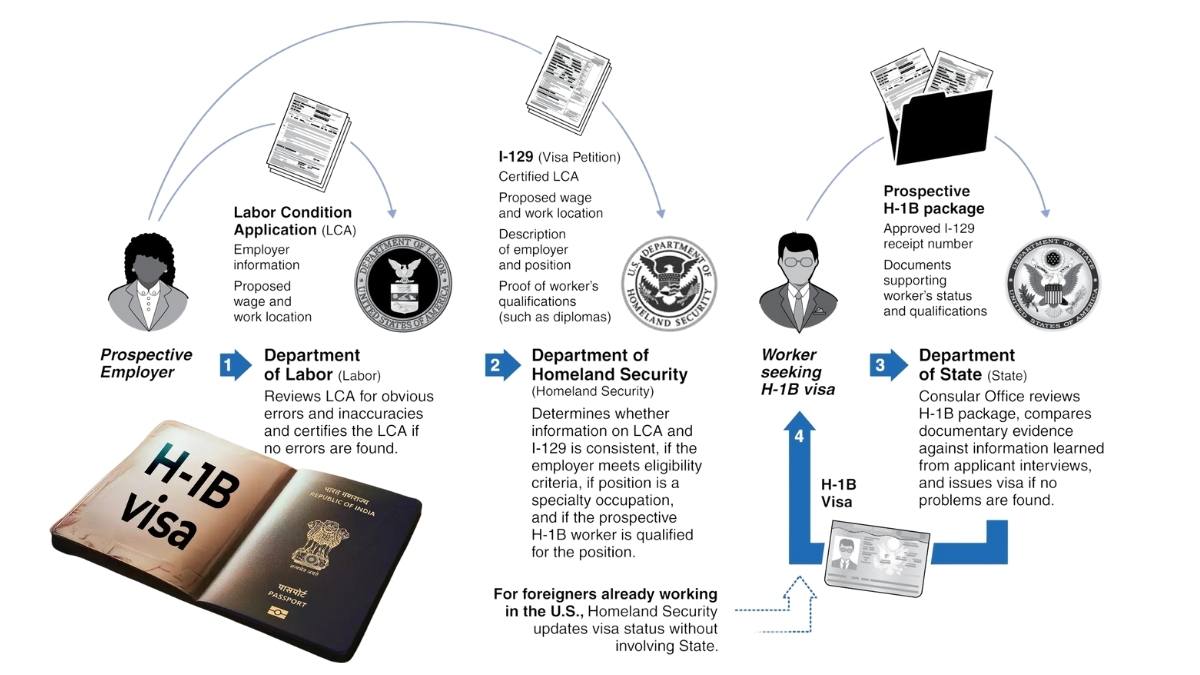The US government has revamped the H-1B visa selection process, aiming to enhance fairness, transparency, and efficiency in the recruitment of international talent. The latest statistics reveal a significant 38% decline in H-1B registrations compared to the previous year. Notably, Indian applicants have secured a remarkable 72.3% of the 386,000 H-1B visas awarded in 2023. In a significant move, the new regulations are set to eliminate deceptive tactics and ensure that all applicants have equal opportunities, as stated by the US Citizenship and Immigration Services (USCIS).
In the year 2025, the landscape of applications saw approximately 442,000 unique individuals stepping forward, marking a subtle decline from the 446,000 recorded in 2024. In a notable shift, the average number of registrations per applicant has decreased from 1.70 to 1.06. India remains the leading nation for these visas, offering IT professionals a gateway to the US labour market. The initial validity of the visa spans three years, with the possibility of extending it for a total of up to six years.
While the $10 registration fee may seem manageable, there are additional hurdles to navigate, including the challenge of securing consular appointments for document submission. In Chennai, the US Consulate is the go-to destination for all Dropbox submissions related to H-1B visas. Recent adjustments to regulations are set to alleviate appointment delays at US consulates while enhancing the efficiency of the renewal process for H-1B visa holders.
The ongoing discussion surrounding the H-1B visa frequently centres around India, given that Indian professionals represent the largest group of beneficiaries in this program. In a striking trend, more than 70% of H-1B visas granted by the United States are awarded to Indian nationals. This significant influx has contributed to a remarkable threefold increase in the Indian-origin population residing in America over the past quarter-century. The visa program has been instrumental in enhancing the technology sector and various other industries across both nations. Despite the challenges, Trump’s inner circle remains focused on this pivotal issue, complicating the administration’s ability to establish a definitive position.
The H-1B visa stands out as a coveted non-immigrant option that enables U.S. companies to bring in foreign talent for specialised roles across various fields, including technology, engineering, medicine, finance, and education. This visa has become a coveted opportunity on a global scale, particularly attracting skilled professionals hailing from India and China. The H-1B visa boasts several essential features that make it a sought-after option for skilled professionals. Applicants must possess a bachelor’s degree or higher in a specialised field, ensuring that the job in question requires specialised knowledge. This visa, initially valid for three years, has the potential to extend for a total of up to six years. Furthermore, the worker faces a pivotal decision at the end of this period: either depart the U.S. or pursue permanent residency through a Green Card application.
Each year, the U.S. government sets a limit on the issuance of H-1B visas, capping the total at 85,000. This includes 65,000 for general applicants and an additional 20,000 reserved for individuals holding a master’s degree from a U.S. institution. However, it’s noteworthy that universities, research institutions, and non-profit organisations enjoy an exemption from this cap, which gives them greater flexibility in hiring skilled foreign workers. A U.S. employer sponsors the visa, which entails that a company is responsible for filing a petition on behalf of the worker. It is important to note that individuals seeking an H-1B visa cannot initiate the application process independently.
The countdown begins for the initial registration period for the fiscal year 2026 H-1B cap, set to open at 10:30 PM IST on March 7, 2025, and closing at 10:30 PM IST on March 24, 2025. Mark your calendars for this crucial window of opportunity! In a streamlined approach to the selection process, prospective petitioners and their representatives are now required to utilise a USCIS online account. This digital platform facilitates the electronic registration of each beneficiary, along with the payment of the corresponding registration fee, ensuring a more efficient experience for all involved. In an important update for applicants, USCIS has announced that if it receives registrations for a sufficient number of unique beneficiaries by the deadline of March 24, a random selection process will take place. Notifications regarding the selection will be conveniently sent through users’ USCIS online accounts, ensuring a streamlined communication experience for all involved. In the event that the required number of unique beneficiaries does not meet expectations, all properly submitted registrations from the initial period will be considered for selection.
In a significant move, the U.S. Department of Treasury has announced a temporary boost in the daily credit card transaction limit, elevating it from $24,999.99 to an impressive $99,999.99. This change is set to take effect for the FY 2026 H-1B cap season, marking a noteworthy shift in financial regulations. For transactions exceeding $99,999.99, utilising the Automated Clearing House (ACH) is an option. However, it’s advisable for the payor to notify their bank beforehand to ensure that any potential ACH block on their account is lifted.
In a significant update for FY 2026, enhancements have been made to organisational and representative accounts for H-1B filing. These improvements include the exciting opportunity for paralegals to collaborate with multiple legal representatives, streamlining the process for legal representatives to add paralegals to their company clients. Additionally, certain fields in Form I-129 can now be pre-populated from selected H-1B registrations, making the filing process more efficient. Furthermore, the ability to prepare a spreadsheet of H-1B beneficiary data and upload it for pre-population in H-1B registrations marks a notable advancement in simplifying the application process.
